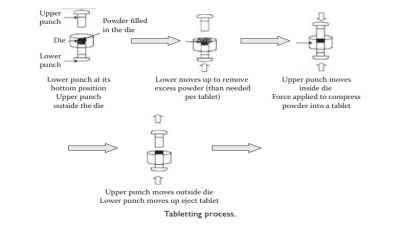Powders as dosage forms
| Home | | Pharmaceutical Drugs and Dosage | | Pharmaceutical Industrial Management |Chapter: Pharmaceutical Drugs and Dosage: Powders and granules
Although the use of powders as a dosage form has been replaced largely by the use of tablets and capsules in modern medicine.
Powders as dosage
forms
Although
the use of powders as a dosage form has been replaced largely by the use of
tablets and capsules in modern medicine, they represent one of the oldest
dosage forms and present certain advantages that have led to their continued
use as pharmaceutical dosage forms.
Types of powder dosage forms
Powders
as dosage forms can be classified based on their usage and/or phys-ical
characteristics as detailed in Sections .
1. Oral powders in unit dose sachets
Powders
containing drugs intended for children, such as antibiotics, are commonly made
available in powder-filled unit-dose sachets. These pow-ders are intended for
administration after premixing with a food product, such a yogurt or juice. For
example, the antibiotic Augmentin (amoxicillin in combination with clavulanic
acid) and probiotics are available as a sachet. The powder blend is required to
have a sweet taste, pleasant fla-vor, appealing color, and an acceptable mouthfeel.
Uniform filling of the powder blend in sachets is the only major concern in the
dispensing of this dosage form.
2. Powders for oral solution or suspension
Powders
for reconstitution into an oral solution or suspension are com-monly dispensed
to the patient in multidose bottles. The pharmacist recon-stitutes the powder
using water, and the patient is instructed to consume a defined dose, by
volume, of the resulting suspension. This mode of drug dispensing is intended
to minimize the effects of physical instability of the suspension and/or the
chemical instability of the drug compound on storage. This dosage form is
exemplified by amoxicillin powder for oral suspension.
The
powder blend is required to have a sweet taste, pleasant flavor, appealing color,
and an acceptable mouthfeel after reconstitution. Stability of both the dry
powder and the reconstituted suspension are important considerations. Also, in
addition to the uniform filling of the powder blend in bottles, dose-to-dose
uniformity of dispensed solution or suspension after reconstitution of a bottle
of powder needs to be established.
3. Bulk powders for oral administration
Herbal
medicines, such as laxatives, are commonly dispensed in bulk powder containers
for dose dispensing and administration by the patient. The husk of the plant
ispaghula as a laxative exemplifies these. These powders must be rel-atively
nontoxic with a wide range of well-tolerated doses. These are generally over
the counter products that are meant for self-medication by the patient.
4. Effervescent granules
Effervescent
granules are sold as bulk powders intended for dispensing of a unit dose and
reconstitution with water to form a solution by the patient immediately before
administration. Upon contact with water, effervescence is produced by the
reaction between an acidic component, such as succinic acid or tartaric acid,
and a carbon dioxide-releasing basic component, such as sodium carbonate or
bicarbonate. Effervescent granules must be kept in dry state to prevent this reaction
before reconstitution by the patient.
5. Dusting powders
Dusting
powders are intended for external, local application. The antibiot-ics in
powder form for application to open skin wounds exemplify these.
Characteristics
of powder blends for their use as dusting powders include low and flexible
dose, low and relatively uniform particle size, high density and low
aerosolization, and nongrittiness.
6. Dry powder inhalers
Dry
powder inhalers (DPIs) are devices that deliver medication to the lungs using an
inhalation device in the form of a dry powder. These devices are commonly used
for drug delivery for local action, for example, for asthma, bronchitis, and
emphysema.
Powder
characteristics required for their use in DPIs include good flow, lack of
adhesion to the material of package, low and uniform particle size for
deposition in the appropriate region of the lung, and an adequate low drug
dose.
Advantages of extemporaneous compounding of powders
Compounding
of powders for dispensing in pharmacy presents the advan-tages of flexibility
in dosing and a relatively good chemical stability. There are, however,
disadvantages to extemporaneous compounding of powders as a dosage form. The
preparation methods are time consuming and are generally not suitable for drugs
that are highly potent, unpleasant tasting, or hygroscopic.
The
compounded powders can either be dispensed in unit doses or as bulk powders in
a multidose container. The dispensing of bulk powders has a further
disadvantage of dosage inaccuracy resulting from several fac-tors such as the
BD of powder, consolidation during handling, and the method of measuring the
dose by the patient. For these reasons, the dis-pensing of bulk powders is
restricted to drugs with some dosage flexibility. These include, for example,
herbal and other natural products such as laxa-tives and nutraceuticals and
dusting powders intended for external, local application.
Extemporaneous compounding techniques
Extemporaneous
compounding of powders as dosage forms in the phar-macy utilizes the same basic
pharmaceutical processes, such as weighing, mixing, and sifting—with
differences in the equipment used and scale of compounding. For example:
·
Efficient mixing by geometric dilution of the component in
the least quantity, such as the potent drug, is carried out by mixing it with
an equal quantity of the larger component, such as a diluent, followed by
repeated mixing with double the quantity of the larger component.
·
A pestle-and-mortar is typically used for mixing powders in
a circular motion with the application of shearing force ( trituration). In
addition to mixing, trituration helps reduce the bulkiness, and tends to reduce
and normalize the particle size of powder components.
·
Powdered solids can be incorporated into ointments and suspen-sions
by forming a paste using water as an insoluble liquid medium. The paste is
triturated using a pestle-and-mortar or a spatula on an ointment slab for
uniform mixing and particle size reduction (levigation).
Related Topics

